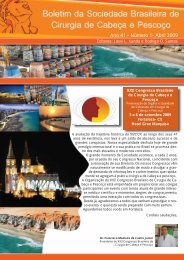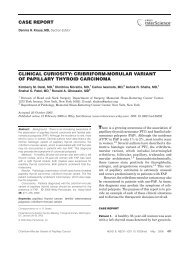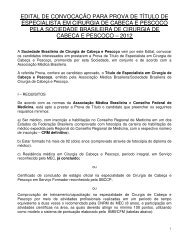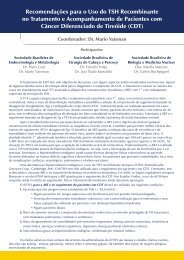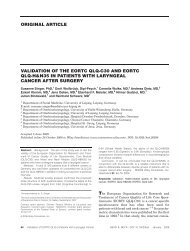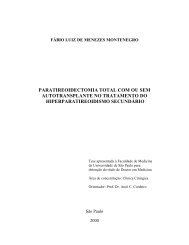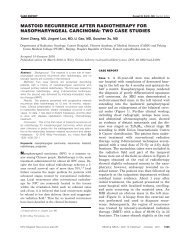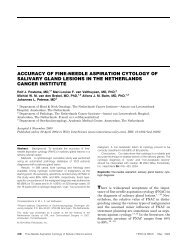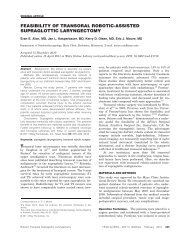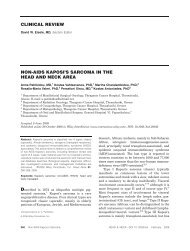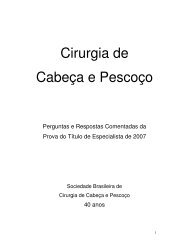Hypothyroidism caused by a nonvisible lingual thyroid
Hypothyroidism caused by a nonvisible lingual thyroid
Hypothyroidism caused by a nonvisible lingual thyroid
Create successful ePaper yourself
Turn your PDF publications into a flip-book with our unique Google optimized e-Paper software.
CASE REPORTDennis H. Kraus, MD, Section EditorHYPOTHYROIDISM CAUSED BY A NONVISIBLELINGUAL THYROIDAlon Grossman, MD, David Olonovski, MD, Erez Barenboim, MDIsraeli Air Force Aero Medical Center, Tel Hashomer, Israel.E-mail: alon2209@012.net.ilAccepted 5 July 2004Published online 1 October 2004 in Wiley InterScience (www.interscience.wiley.com). DOI: 10.1002/hed.20123Abstract: Background. Lingual <strong>thyroid</strong> is a developmentalanomaly <strong>caused</strong> <strong>by</strong> failure of migration of the <strong>thyroid</strong> gland to itsnormal position in the neck. This anomaly is usually manifested inchildhood as hypo<strong>thyroid</strong>ism or local symptoms.Methods. We present a case of a 32-year-old patient inwhom <strong>lingual</strong> <strong>thyroid</strong> was diagnosed after complaints of achronic cough. Thyroid-stimulating hormone levels were significantlyelevated. Sonograms of the neck revealed atrophy of both<strong>thyroid</strong> lobes, with nonhomogeneous consistency and nolymphadenopathy. Technetium-99m scan revealed uptake atthe tongue base, with no uptake at the neck or other locations.Results. L-thyroxine treatment was begun, with progressivedecrement in <strong>thyroid</strong>-stimulating hormone levels and cessationof the cough.Conclusion. This case is unique in both the advanced age ofthe patient and the unusual clinical presentation. A 2004 WileyPeriodicals, Inc. Head Neck 26: 995–998, 2004Keywords: <strong>lingual</strong> <strong>thyroid</strong>; hypo<strong>thyroid</strong>ismincidence varies between 1/3000 and 1/10,000, yetthe tongue is the most frequent ectopic location ofthe <strong>thyroid</strong>. The age of presentation ranges frombirth to 74 years, although most cases are diagnosedin childhood. We describe a 32-year-oldmilitary aviator who was diagnosed with <strong>lingual</strong><strong>thyroid</strong> because of a complaint of chronic cough.This case is unique in both the relatively lateage of the patient at the time of diagnosis andthe unusual clinical presentation. The fact thatthe patient was a military aviator involved ineveryday strenuous activity is also unique, becauseprevious reports have demonstrated arelationship between stress and local symptoms,whereas in our patient no apparent relationshipwas demonstrated.Lingual <strong>thyroid</strong> is a rare developmental anomalydefined as the presence of <strong>thyroid</strong> tissue in themidline of the base of the tongue between the circumvallatepapillae and the epiglottis. Its clinicalCorrespondence to: A. GrossmanB 2004 Wiley Periodicals, Inc.CASE REPORTA 32-year-old F-16 pilot was seen <strong>by</strong> his primarycare physician with a 3-month history of nonproductivecough. His medical history was unremarkable,and he was taking no medications. Hehad no additional complaints, but when specificallyasked, he recalled gaining 4 kg in thepreceding 4 months. The physical examinationwas unrevealing, including the ear, nose, and<strong>Hypo<strong>thyroid</strong>ism</strong> from Nonvisible Lingual Thyroid HEAD & NECK November 2004 995
throat (ENT) examination. Routine laboratorytests revealed a mild normocytic, normochromicanemia (hemoglobin, 12.7 g/dL; mean corpuscularvolume [MCV], 86 fL; mean corpuscular hemoglobin[MCH], 26.2 pg/cell) and mildly elevatedcholesterol (207 mg/dL). Similar hemoglobin valueswere observed in the past, and his ferritinvalues were within normal limits. Thyroid functiontests revealed significantly elevated <strong>thyroid</strong>stimulatinghormone (TSH) levels with free serumtriiodothyronine (FT 3 ) and free serum thyroxine(FT 4 ) at the lower limit of normal values. Followup<strong>thyroid</strong> function tests revealed elevated TSHand low FT 4 , with FT 3 being at the lower limit ofnormal values He was restricted from continuedflying duty pending the completion of work-up ofhis <strong>thyroid</strong> function abnormality.His chest X-ray was found to be normal. Anultrasound examination of the neck revealed atrophyof both <strong>thyroid</strong> lobes with nonhomogenousconsistency and no lymphadenopathy. A technetium-99mscan revealed uptake at the tonguebase with no uptake at the neck or at other locations.A diagnosis of <strong>lingual</strong> <strong>thyroid</strong> was made,and L-thyroxine treatment was begun with a progressivedecrement in TSH values and disappearanceof the cough.DISCUSSIONLingual <strong>thyroid</strong> is the term applied to a mass ofectopic <strong>thyroid</strong> tissue located at the tongue baseat the midline, usually between the circumvallatepapillae and the epiglottis, in the area of theforamen cecum. It is believed to result from defectivedescent of the <strong>thyroid</strong> anlage from itsembryonic position at the base of the tongue to itsnormal pretracheal location, which usually occurson weeks 3 to 7 of embryonic development. Defectsin migration may lead to locations of the<strong>thyroid</strong> gland in other midline structures such asthe trachea, the esophagus, or near the hyoidbone. Hickman 1 reported the first case of <strong>lingual</strong><strong>thyroid</strong> in 1869, and 400 cases have been describedin the literature to date. This is the mostcommon benign mass found at the junction of theanterior two thirds and the posterior one third ofthe tongue. Postmortem studies indicate that upto 10% of people have <strong>thyroid</strong> tissue remnantsnear the base of their tongue, 2,3 although clinicallyapparent <strong>lingual</strong> <strong>thyroid</strong> is an unusualcondition, with a few hundred cases reported inthe literature. The estimated frequency of clinicallysignificant <strong>lingual</strong> <strong>thyroid</strong> varies between1/3000 and 1/10,000. 4 In 70% of these cases, the<strong>lingual</strong> <strong>thyroid</strong> is the only functional <strong>thyroid</strong>tissue. 5 <strong>Hypo<strong>thyroid</strong>ism</strong> is observed in an estimated33% of the cases and is commonly precipitated<strong>by</strong> increased physiologic demands. 6 Thisentity is much more prevalent in females, with amale-to-female ratio of 1:3 to 1:8. 7The pathogenesis of this condition remainsunknown. It is postulated that maternal anti<strong>thyroid</strong>antibodies may arrest the gland’s descentand predispose the patient to poor <strong>thyroid</strong> functionlater in life. 8 The incidence of <strong>thyroid</strong> diseaseamong family members of patients with <strong>lingual</strong><strong>thyroid</strong> is higher than among the populationat large. 9The symptoms of <strong>lingual</strong> <strong>thyroid</strong> are variableand depend on the patient’s age. Infants andyoung children are usually diagnosed on routinescreening and often have failure to thrive andmental retardation. Older children, adolescents,and adults are diagnosed after the onset of obstructivesymptoms, such as dysphagia, dysphonia,dyspnea, a cough worse on lying down, orlocal hemorrhage. Glandular hypertrophy occursin these populations as a response to the rise inTSH levels that is generated <strong>by</strong> the increase inmetabolic demand for <strong>thyroid</strong> hormone that occursin situations such as puberty, pregnancy,trauma, infection, or menopause. 10The initial evaluation of a <strong>lingual</strong> <strong>thyroid</strong>involves a thorough head and neck examination.The mass appears light pink to bright red or blue,and its surface can be smooth or irregular.Flexible or rigid endoscopy of the upper airwayis performed to determine the size of the <strong>thyroid</strong>and airway patency. Laboratory evaluationshould include <strong>thyroid</strong> function tests, which frequentlydemonstrate normal to low levels of T3and T4 and low levels of TSH and thyroglobulin.Hyper<strong>thyroid</strong>ism, although rare, has been reported.11 A technetium scan should be used toconfirm the diagnosis. These scans frequentlyshow radionuclide activity at the level of themouth and no apparent activity in the normalposition in the neck. CT provides an accuratemethod of determining the gland size, and it canbe performed without contrast, because the <strong>thyroid</strong>tends to accumulate iodine. 12 MRI is consideredthe method of choice to study <strong>lingual</strong><strong>thyroid</strong>s in a noninvasive way because of its multiplanarcapabilities and its high degree of softtissue resolution, which result in better delineationof the lesion. 13 Ultrasound is less dependableand is used to follow an enlarging component of996 <strong>Hypo<strong>thyroid</strong>ism</strong> from Nonvisible Lingual ThyroidHEAD & NECK November 2004
a <strong>thyroid</strong> gland without the need for additionalionizing radiation.Malignant degeneration in <strong>lingual</strong> <strong>thyroid</strong>seems to be the same as for orthotopic <strong>thyroid</strong>tissue. 3 Lingual <strong>thyroid</strong> carcinoma has been describedin patients from the age of 12 to the ageof 86, with the mean age of presentation in thethird decade. 14 No risk factors have been describedin the literature, but it is assumed thatthey are the same as those for malignancy of acervical <strong>thyroid</strong> (x-ray exposure of the head, neck,or mediastinum in infancy or childhood). Thereare no clinical findings that can differentiate<strong>lingual</strong> <strong>thyroid</strong> carcinoma from a symptomatic<strong>lingual</strong> <strong>thyroid</strong>. Therefore, it is recommendedthat biopsy or aspiration be taken in every case of<strong>lingual</strong> <strong>thyroid</strong> to rule out <strong>thyroid</strong> carcinoma. 15The natural history of <strong>lingual</strong> <strong>thyroid</strong> carcinomais unknown because of the rarity of this condition,yet most cases described in the literature did notextend beyond the tongue.Treatment of <strong>lingual</strong> <strong>thyroid</strong> is controversial.All patients should receive lifelong thyroxinesuppression, even those with small and asymptomatic<strong>lingual</strong> <strong>thyroid</strong>s, because this will preventthe gland’s enlargement, diminish the risk ofmalignancy, and prevent hypo<strong>thyroid</strong>ism. 16 Theectopic <strong>thyroid</strong> tissue can be ablated <strong>by</strong> a therapeuticdose of 131 I. This modality is safe andeffective and should be included in the algorithmwhen formulating a treatment plan for the symptomaticpatient. 17 Surgery is reserved for thosewhose initial symptoms worsen while on suppressivetherapy. Surgery becomes crucial in cases ofrecurrent hemorrhage, severe dysphonia or dysphagia,or significant airway compromise. CT andMRI are helpful in determining the best approachfor total gland excision. Complete excision ofthe gland is difficult, and in most cases, thereare remnants left at the base of the tongue, whichhave the potential to enlarge in the future unlesssuppressed with <strong>thyroid</strong> replacement therapy.Our case is unique in several aspects. Therelatively late age of presentation of our patientis surprising, because most cases of <strong>lingual</strong> <strong>thyroid</strong>are diagnosed at times of increased metabolicdemands. Our patient was a militaryaviator, who was certainly exposed to increasedmetabolic demands, whether while being a studentaviator or while performing certain militarymissions. Previous reports linked stress anddevelopment of symptoms in patients with<strong>lingual</strong> <strong>thyroid</strong>, and there are descriptions ofsymptomatic cases linked to enrollment andtraining in the army. 16 Our patient completeda difficult army training program with no apparentsymptoms. No apparent cause of increasedmetabolic demands was identified before hisclinical presentation, and we do not have a goodexplanation for the timing of his symptoms. Thepatient did gain 4 kg in weight in the monthsbefore the diagnosis. This weight gain may haveincreased his metabolic demands and <strong>caused</strong> his<strong>lingual</strong> <strong>thyroid</strong> to become symptomatic, but theymay also have been a result of his hypo<strong>thyroid</strong>ism.The presenting symptom of prolonged cough inour patient is also unique. Most cases described inthe literature of adults with symptomatic <strong>lingual</strong><strong>thyroid</strong> manifested as dysphagia, dysphonia, aforeign body sensation in the throat, bleeding, orintermittent respiratory obstruction. A cough,which worsens on lying down, has been describedbut is rare. 11 In our patient, no other cause for thecough was identified, and the cough improved onstart of treatment; therefore, we assume that thecough was related to the <strong>lingual</strong> <strong>thyroid</strong>, althoughthe <strong>lingual</strong> <strong>thyroid</strong> was not visible on the ENTexamination. The laboratory evidence of hypo<strong>thyroid</strong>ismand the technetium scan eventuallyled to the diagnosis, despite a normal ENT examination.We recommend that <strong>thyroid</strong> functiontests be included in the laboratory evaluation ofpatients with complaints of the upper airway,including prolonged cough. Those with impaired<strong>thyroid</strong> function tests should undergo a thoroughevaluation for a <strong>lingual</strong> <strong>thyroid</strong> <strong>by</strong> an otolaryngologist.Even in cases of a normal ENT examination,a technetium scan should be performed,because clinically significant <strong>lingual</strong> <strong>thyroid</strong> maybe difficult to diagnose solely on clinical grounds.Should a <strong>lingual</strong> <strong>thyroid</strong> be found on a radionuclidescan, we believe that treatment withlevothyroxine should be started to suppress the<strong>thyroid</strong> gland. In most cases, this treatment willcause decrement of the gland and resolution ofsymptoms. If symptoms fail to resolve or thegland fails to decrease in size, a biopsy should betaken to rule out a malignancy.CONCLUSIONSLingual <strong>thyroid</strong> is a rare entity that has the potentialto present at any age. The clinical presentationin adults is variable, but most patientshave symptoms that result from local irritation.The combination of such complaints and disturbancesin <strong>thyroid</strong> function tests should promptthe physician to search for a <strong>lingual</strong> <strong>thyroid</strong> <strong>by</strong><strong>Hypo<strong>thyroid</strong>ism</strong> from Nonvisible Lingual Thyroid HEAD & NECK November 2004 997
use of a thorough clinical examination and a radionuclidescan.REFERENCES1. Hickman W. Congenital tumor of the base of the tongue,causing death <strong>by</strong> suffocation. Trans Pathol Soc London1869;20:160–163.2. Baughman RA. Lingual <strong>thyroid</strong> and <strong>lingual</strong> thyroglossaltract remnants: a clinical and histopathologic study withreview of the literature. Oral Surg 1972;34:781–798.3. Sauk JJ. Ectopic <strong>lingual</strong> <strong>thyroid</strong>s. J Pathol 1970;102:239–243.4. Williams JD, Scalafani AP, Slupchinskij O, Douge C.Evaluation and management of the <strong>lingual</strong> <strong>thyroid</strong> gland.Ann Otol Rhinol Laryngol 1996;105:312–316.5. Monroe JB, Fahey D. Lingual <strong>thyroid</strong>. Arch OtolaryngolHead Neck Surg 1975;101:574–576.6. Nienas FW. Lingual <strong>thyroid</strong>: clinical characteristics of 15cases. Ann Intern Med 1973;79:205.7. Prasad KC, Bhat V. Surgical management of <strong>lingual</strong><strong>thyroid</strong>: a report of 4 cases. J Oral Maxillofac Surg 2000;58:227–232.8. van der Gagg RD, Drexhage HA, Dussault JH. Role ofmaternal immunoglobulins blocking TSH-induced <strong>thyroid</strong>growth in sporadic forms of congenital hypo<strong>thyroid</strong>ism.Lancet 1985;1:246–250.9. Farrel ML, Forer M. Lingual <strong>thyroid</strong>. Aust N Z J Surg1994;64:135–138.10. Wertz ML. Management of undescended <strong>lingual</strong> and subhyoid<strong>thyroid</strong> glands. Laryngoscope 1974;84:507 –521.11. Montgomery MI. Lingual <strong>thyroid</strong>: a comprehensive review.West J Surg 1935;43:661–669.12. Wolf BS, Nakagawa H, Yeh HC. Visualization of the<strong>thyroid</strong> with computed tomography. Radiology 1977;123:368.13. Johnson JC, Coleman LL. Magnetic resonance imagingof a <strong>lingual</strong> <strong>thyroid</strong> gland. Pediatr Radiol 1989;19:461–462.14. Diaz-Arias AA, Bickel JT, Loy TS, Croll GH, Puckett CL,Havey AD. Follicular carcinoma with clear cell changearising in <strong>lingual</strong> <strong>thyroid</strong>. Oral Surg Oral Med Oral Pathol1992;74:206–211.15. Massine RE, Durning SJ, Koroscil TM. Lingual <strong>thyroid</strong>carcinoma: a case report and review of the literature.Thyroid 2001;11:1191 –1196.16. Kansal P, Sakati N, Rifai A, Woodhouse N. Lingual<strong>thyroid</strong>. Diagnosis and treatment. Arch Intern Med 1987;147:2046–2048.17. Danner C, Bodenner D, Breau R. Lingual <strong>thyroid</strong>: I131: aviable treatment modality revisited. Am J Otolaryngol2001;22:276–281.998 <strong>Hypo<strong>thyroid</strong>ism</strong> from Nonvisible Lingual ThyroidHEAD & NECK November 2004



